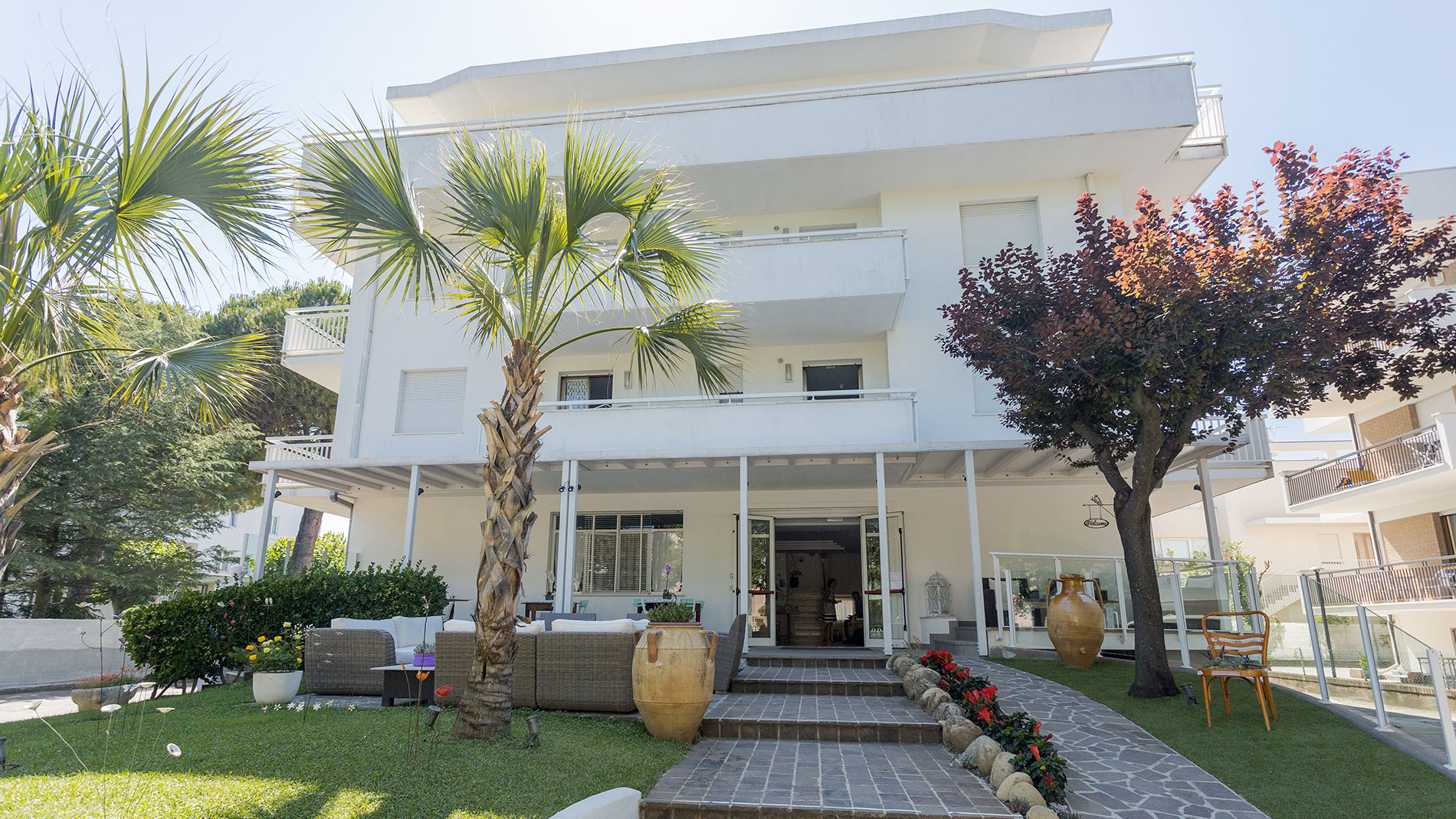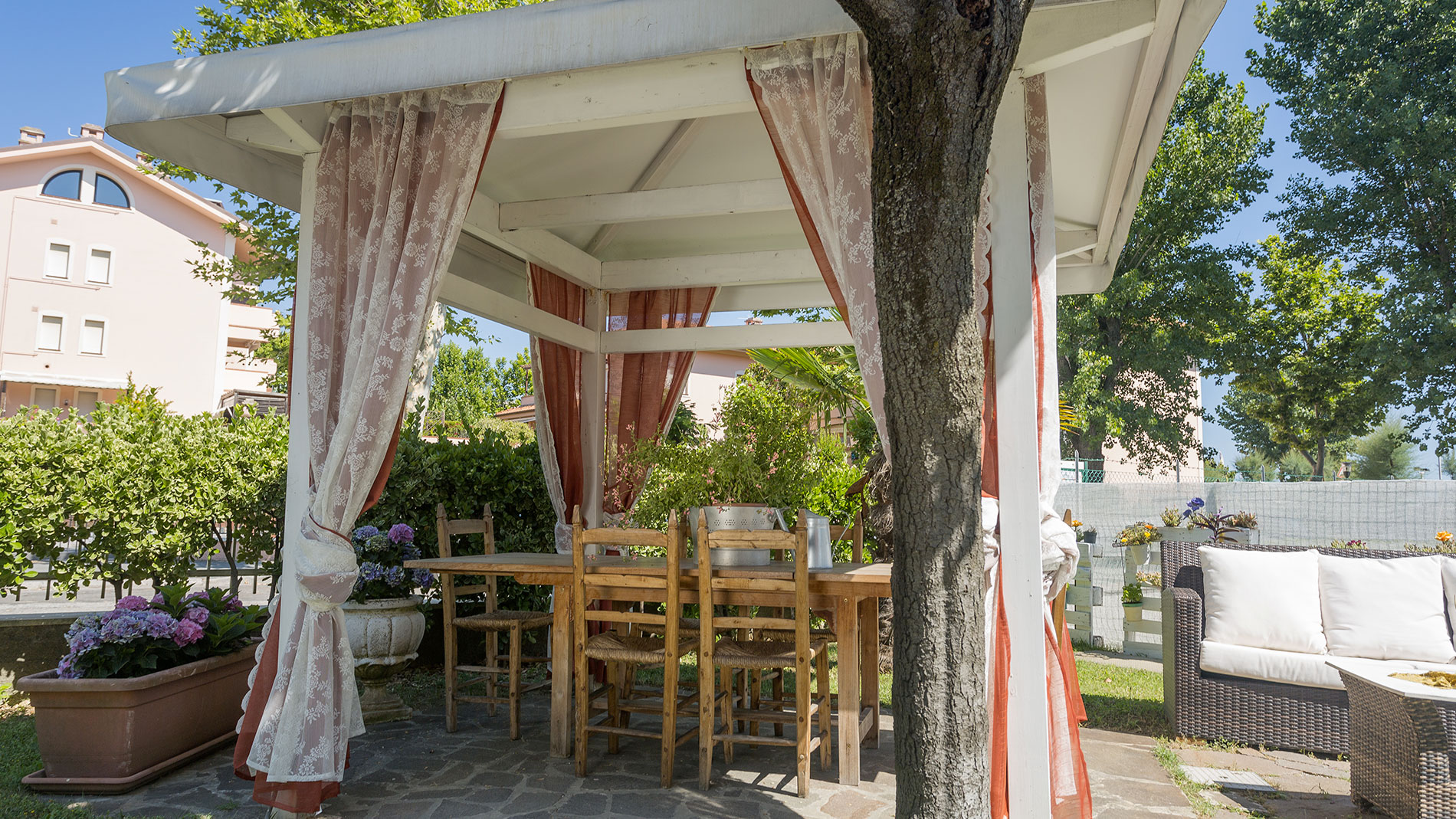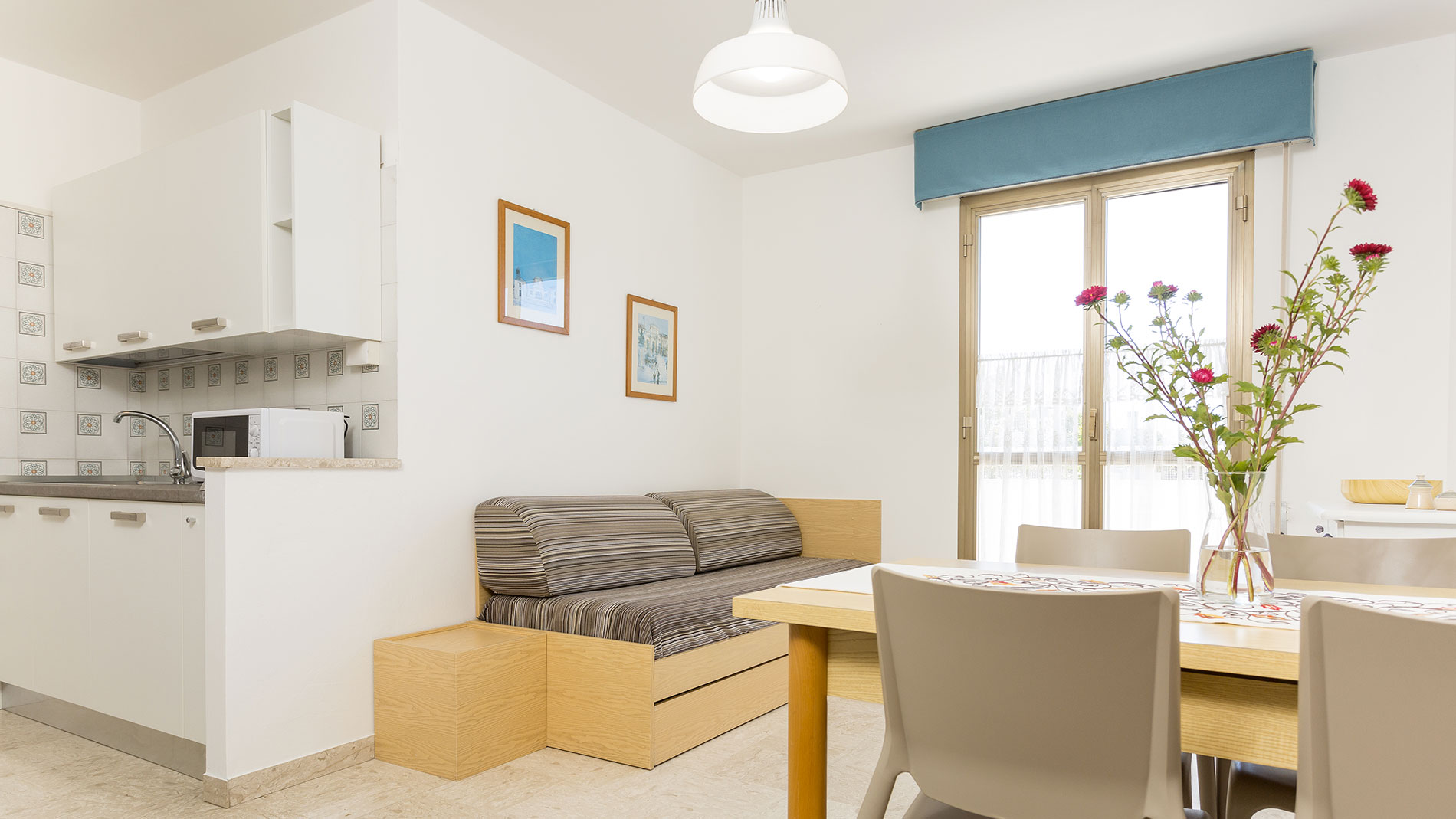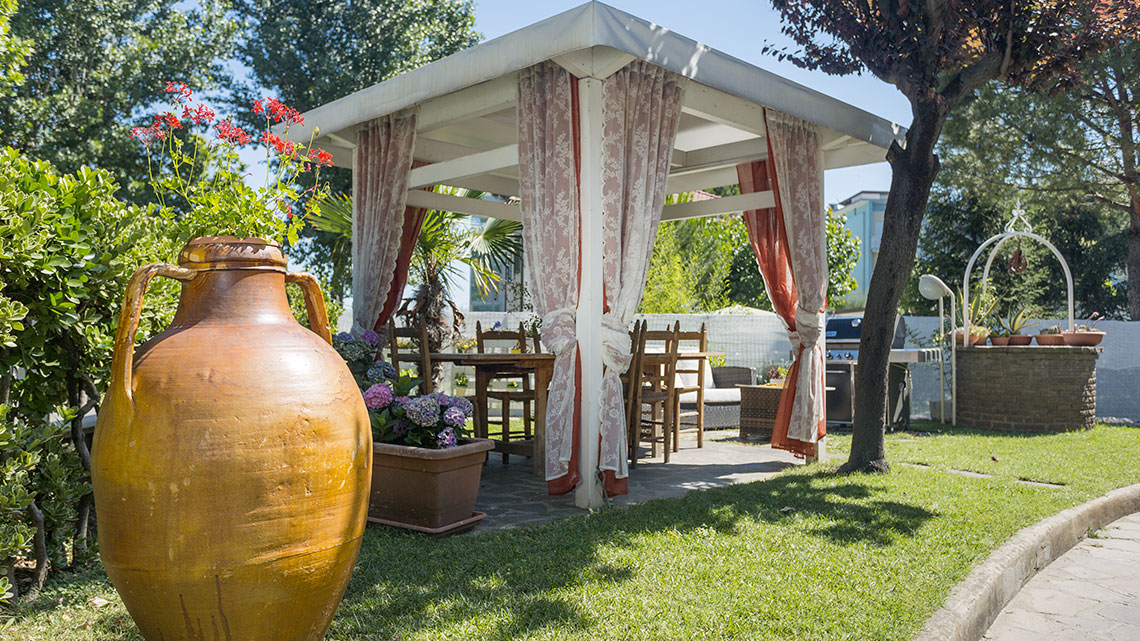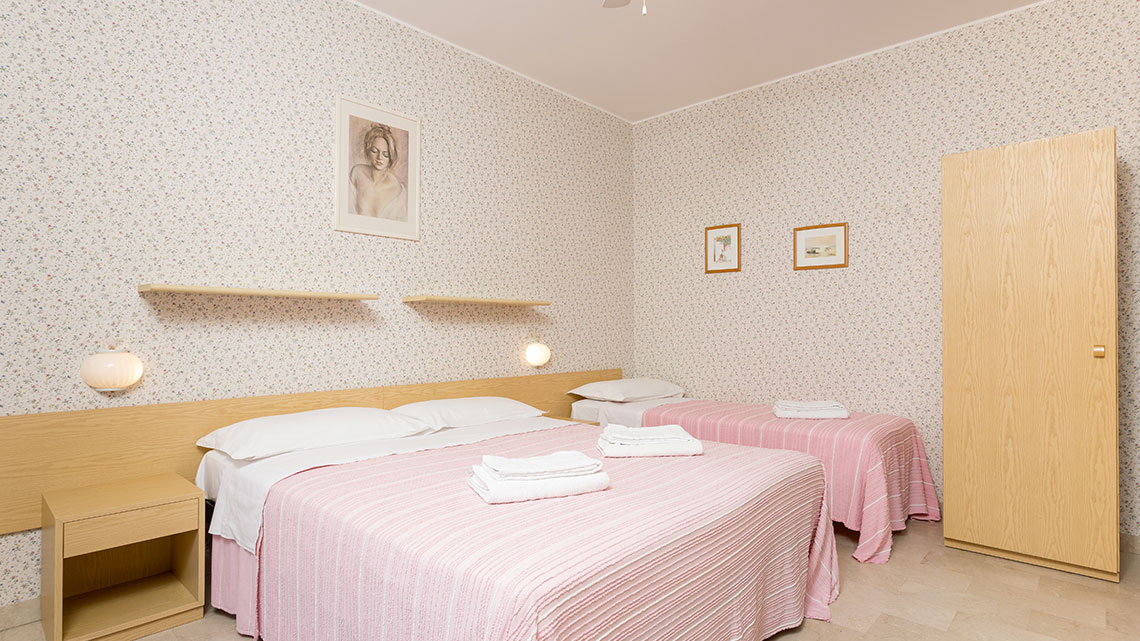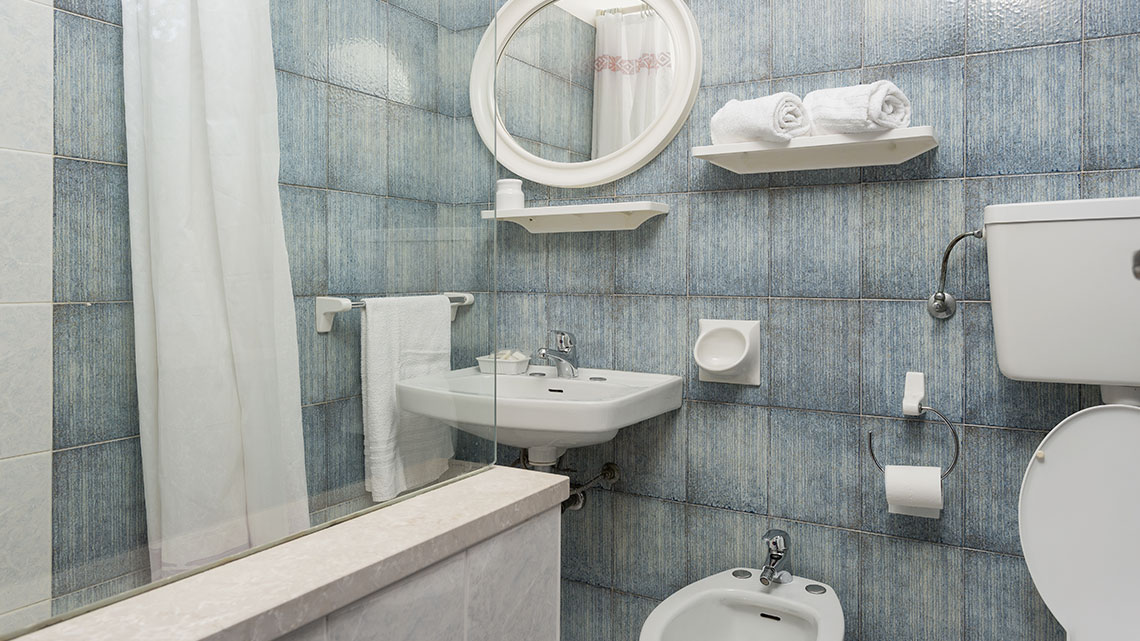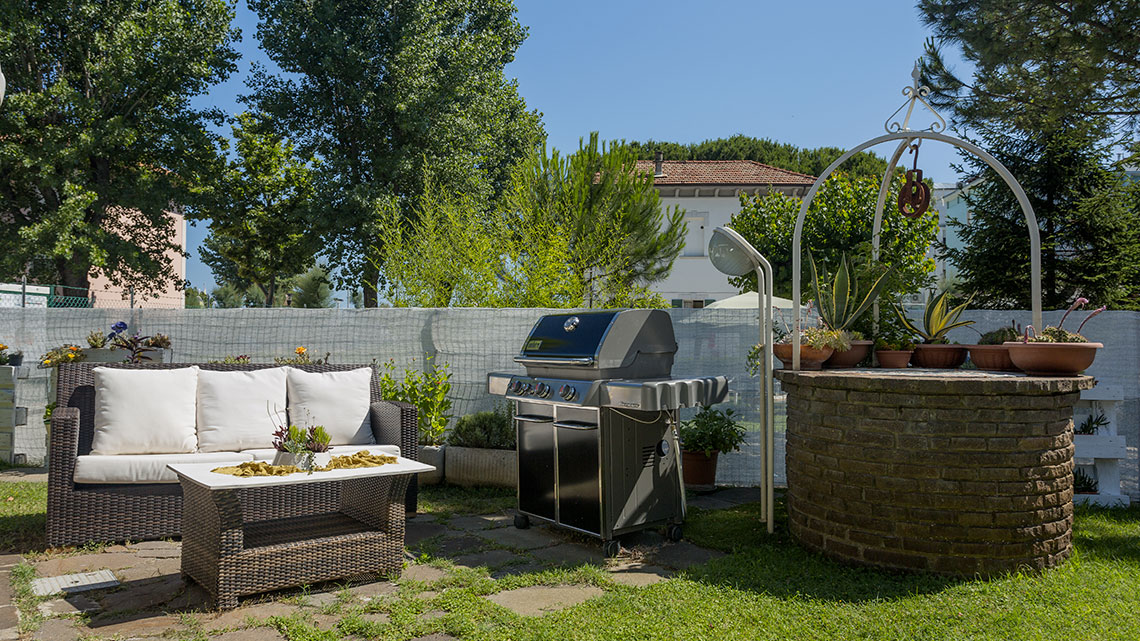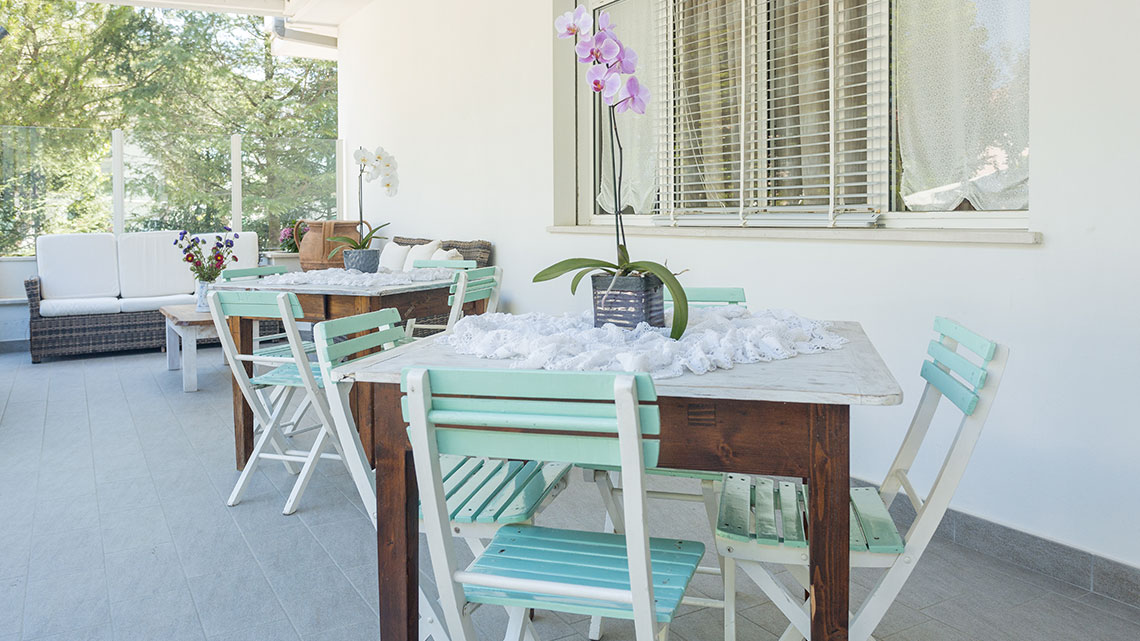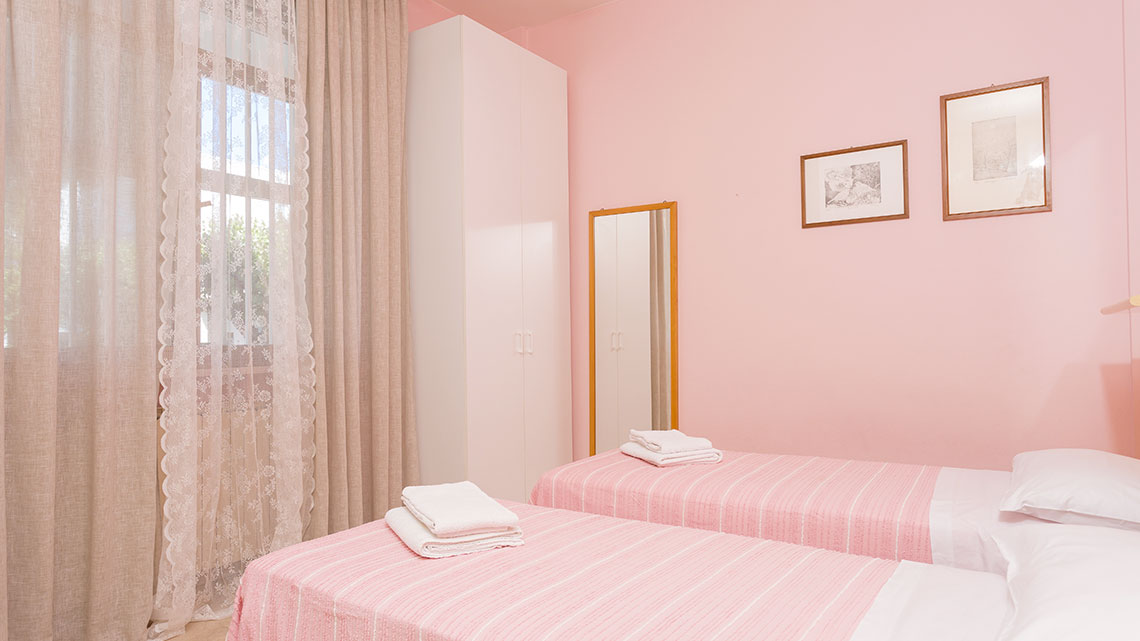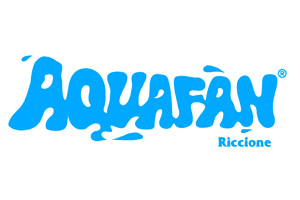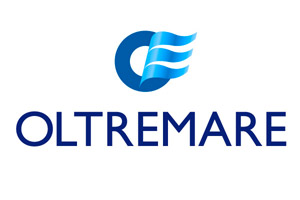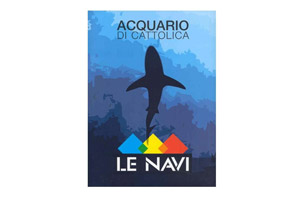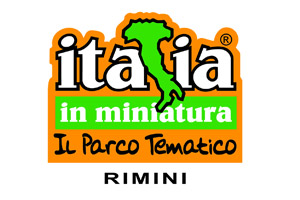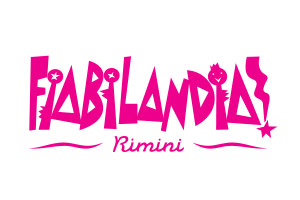
DEL BIANCO APARTMENTS
Del Bianco Appartamenti is located in the quiet spa district in Riccione, only 100 m from the beach, and is well-connected to the new pedestrian footpath along the seafront.
Anyone looking for a holiday characterized by tradition and hospitality will find a welcoming environment complete with all comforts. The spacious garden, equipped with relax corners and barbecue spots, will give you the chance to enjoy lovely evening meals outdoors.
The apartments include a lift, spacious terraces, SAT TV, safe, Wi-Fi connection, hair dryer and fitted kitchens. We also welcome children and provide cots, bed rails, high chairs and baby baths.
Besides the washing machine and the ironing area, our clients have access to our bikes to ride along the cycling paths which head towards Cattolica and Rimini.
Upon arrival, guests will be welcomed with a courtesy kit and beach towels.
Each apartment includes a parking space inside the garden.
Beach Arena, Indiana Golf and the Perle d'Acqua spa are only a stone's throw away and the commercial area in Viale San Martino is also close (400 m), while Viale Ceccarini, famous for fashion and shopping, is only 1.3 km away.
Floor -1
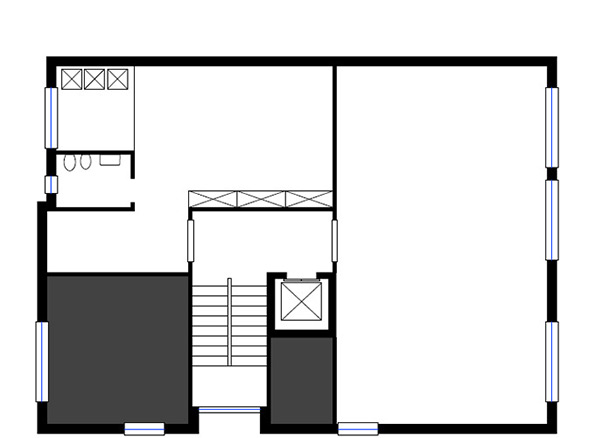
Floor zero
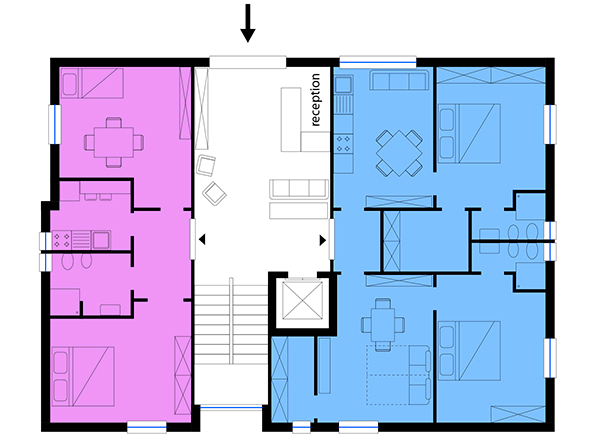
Floor 1st-2nd

Floor 3rd

The land of the province of Rimini is known by all for its extraordinary 40 km of coastline, stretching from Bellaria to Cattolica. Everyone knows the tourism and hospitality on offer along the riviera, but few know how interesting, worthwhile and fascinating the countryside, villages, and rocky landscapes of the 15 municipalities that make up the territory of Malatesta are.
From the Medieval to Renaissance times, the lineage of the Malatesta family is among the most important in Italy, governing many of the cities of Romagna, Marche, Tuscany and Lombardy, but the strongest power it exerted, in the Rimini area, was the leader Sigismondo Pandolfo, famous for his courage and determination.
At the beginning of the 15th century, the contrasts with the neighbouring lords of the Duchy of Urbino, the Montefeltro, came to light and the two leading representatives of the families clashed: Sigismondo Malatesta and Federico da Montefeltro. In this period, the two powerful lords strengthened the defence system building fortresses, castles, towers, for a succession of confrontations, alliances, battles, intrigues and passions of love like that between Paolo Malatesta and Francesca de Polenta, tragically ended at the hands of husband, Gianciotto Malatesta (brother of Paolo) that Dante has made famous, or to Sigismonto, smitten with the young Isolde.
Among these great passions there is also art and culture. As a symbol of power, the period of the Signoria is the time of the great works and masterpieces that are still to be found in the castles, churches, museums and libraries as a testament to their extraordinary artistic value.
After the defeat and death of Sigismund began the inevitable decline of the Malatesta family, at the end of the 15th century power over this land had already passed on to others.
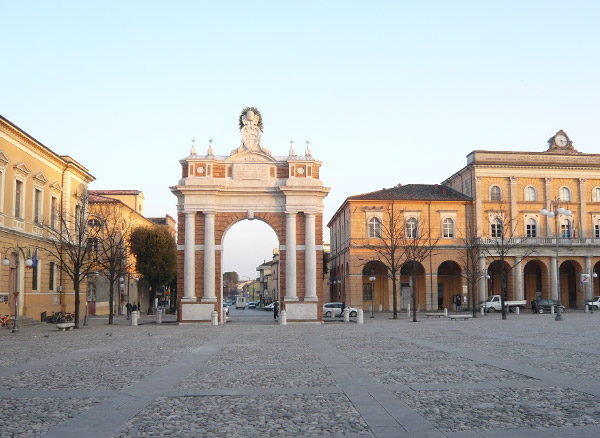
Santarcangelo di Romagna
It has Roman origins and is located on Mount Jupiter, whose first settlement dates back to just after the establishment of nearby Rimini. The construction of Via Emilia, which now runs through the town, was at the time beneficial for trade and population growth. The Malatesta, who ruled in the thirteenth century, made the castle even richer and more important. Noble and popular elements integrate seamlessly, resulting in one of the most striking historical centres of Rimini. In 1984 the title of ‘city of art’ was attributed to Santarcangelo.
Montefiore Conca
The medieval capital of the Conca valley is one of the best preserved and most beautiful of Signoria, not for nothing part of the prestigious circuit of the "most beautiful villages in Italy". From the imposing fortress you can see the mountains of the Marche region and across the Adriatic coast. The atmosphere that surrounds it helps to create a special situation whereby history and nature have found an optimal balance. Numerous exhibitions and art exhibitions are held all year round.

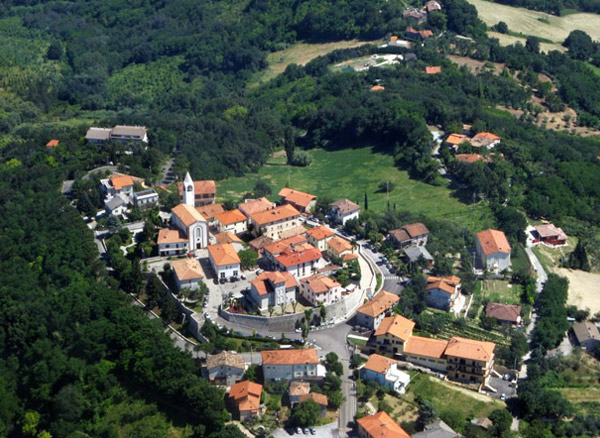
Gemmano
Here is the most unspoilt and unique nature of Signoria. The hills are lush, the signs of human intervention are few and there are also the caves of Onferno. For those who love nature, Gemmano is the setting of a perfect outing.
Mondaino
On the hills where deer once grazed stood a temple dedicated to Diana, goddess of hunting, and it was right here that Mondaino was born, and is revived every year in one of the most carefully organised historical reenactments involving the whole Lordship and all of Emilia Romagna. History bestowed on Mondaino its most singular circular piazza, as well as the palazzos and churches.
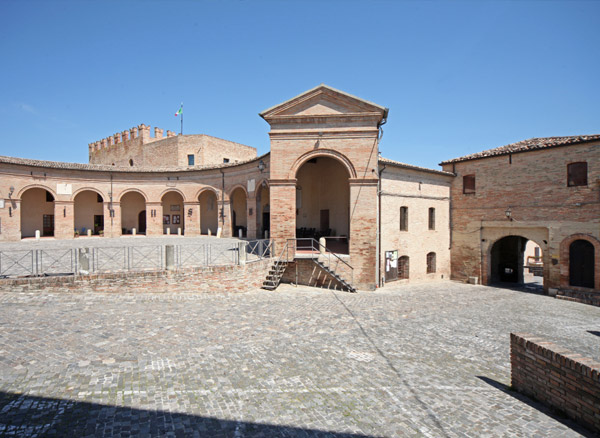
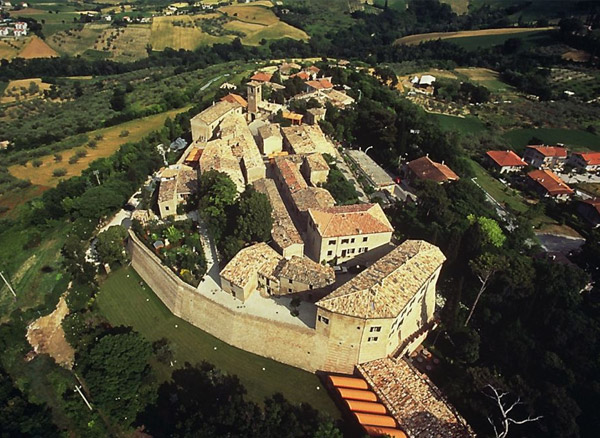
Montegridolfo
A village surrounded by high walls with access protected by a tower with a medieval door, an intact village, which in recent years has been subject to a thorough restoration with the aim of reviving the country according to the culture of tradition, hospitality and tourism.
Gradara
Remarkable is the artistic heritage contained within its walls, which boasts works of great value. In addition to this, there is a magnificent landscape, also recognised by the institutions and therefore carefully protected. Gradara stands as an island between the rolling hills of Marche and is only 3 km away from the sea. It's a magical place where legend and history meet to tell the tragic love story of Paolo and Francesca, sung by Dante, Petrarch, Boccaccio and D'Annunzio. Strolling through its streets, especially at night, by the illuminated fortress surrounded by oak trees, offers a unique romantic setting.

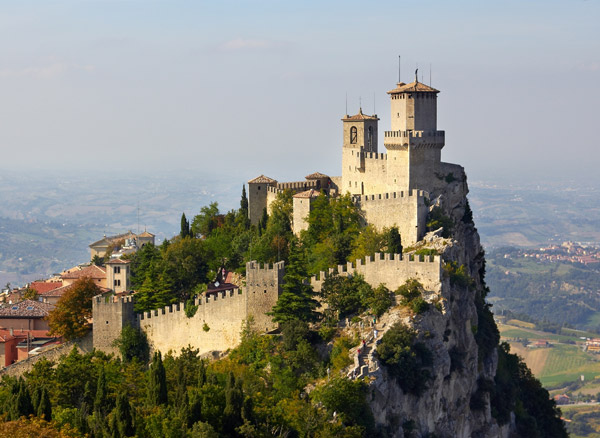
Repubblica di San Marino
In the heart of Italy, on the border between Emilia Romagna and the Marche, the Republic of San Marino covers just 61.196 km2, and is the third smallest country in Europe, behind the Principality of Monaco and the Vatican City. Mount Titan, with its three pens, is the symbol of the country, marking the beginning of the Tuscan-Romagna Apennines and, with its 749 metres above sea level, is the highest point in the country. The mountain has an unusual configuration for the surrounding area, which is dominated by hills. San Marino is the oldest republic of Europe and lives not only in history. Events, festivals, competitions and sporting events, music and theatre are part of a series of proposals to give life to this history for its visitors, evoking new emotions in one of the most fascinating tourist destinations. From shopping to cultural events, there are always many opportunities to visit San Marino.
Cesena
Cesena is located between the Apennines and the sea. Its story tells of Umbrian- Etruscan origins, but over the centuries is the Signoria Malatesta that leaves an indelible mark, such as the Malatesta Library that UNESCO has chosen to include in the list ‘Memoire du Monde’, expanding later to the main square, Piazza del Popolo, overlooked by the Town Hall. It continues uphill, halfway between two borders: the Garampo and the Speziano. On Garampo, behind the Piazza del Popolo, stands a splendid fortress, whose walkway view takes in the entire city as far as the sea. In Spaziano, on the other hand, there is the Benedictine Abbey of Monte that has stood there for over a millennium and collects a highly original collection of votive offerings.
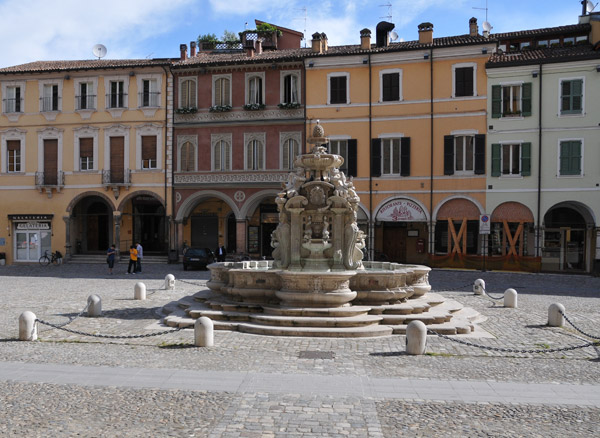

San Leo
The panorama from San Leo is one of the most beautiful and characteristic of the region, with sweeping views of the surrounding mountains and along the valley of the Marecchia to the sea. San Leo, called Montefeltro, stands on a huge boulder impassable from all angles, and it is accessed by a single road cut into the rock. Historically, the city hosted Dante and St. Francis of Assisi. It is only 32 km from Rimini.
Urbino
This is an important centre of the Renaissance and is of extraordinary beauty. It is easy to get immersed in a picturesque journey through harmonious architecture, palaces, residences that belonged to the Court of Montefeltro and scenic spots that open up over the area. Thanks to a refined cultural education, Federico da Montefeltro knew how to concentrate in this space the cream of Italian Renaissance humanist culture, and called the best men and the best artists of his time: Piero della Francesca, Luciano Laurana, Leon Battista Alberti, Francesco di Giorgio Martini. In this cradle of culture, artists such as Raphael and Bramante took their first steps. After the great Renaissance season the city knows and upholds its former splendour, and most recently, the University increased significantly in size in the second half of the last century.
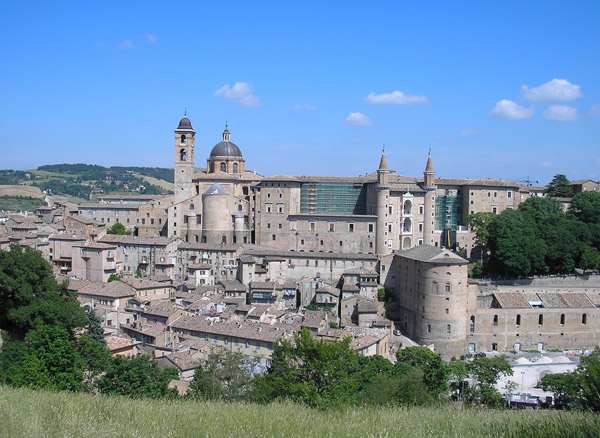

Cycling
Cycling is undoubtedly among the most frequently practiced sports in the area.
The paths between the Malatesta hills and the Montefeltro area stretches for hundreds of kilometres of secondary roads, free of heavy traffic.
There are also many mountain bike routes that stretch across trails surrounded by beautiful landscapes.
Maps and guides have been created in order to practice this sport with ease.
Located at a short distance from our apartments there are important meeting places for cyclists of all levels, where any eventuality or rent of any type of equipment can be organised.
Miganibikes - Teknobikestore - h3o
Our residence offers its guests a special garage for storing their own cycling equipment.

Horseback riding
The hills and the rivers in the area lend themselves optimally to horseback trekking. In the countryside and the hills you can travel dozens of kilometres of trails and tracks suitable for the horses. At a distance of just a few kilometres there are several centres with riding schools of a high standard.
Horses Riviera Resort - Il Fondo - RAWHIDE RANCH & BATEK RANCH Portoverde (RN)

Golf
We can boast an excellent golf centre nearby, where you can spend days filled with challenges, or simply chat and compare notes with other golfers.

Motorcycling
We also meet the needs of lovers of two or four wheels, the nearby Santamonica di Misano Adriatico track not only has a full calendar of events, but in special days dedicated to the public, it offers the chance to get on track with your own motorbike or aboard a kart made available by the track. Misano Circuit
The "residence Del Bianco" was born in the 80's as a result of the desire of the spouses Leda and Enzo Del Bianco to offer a cozy, comfortable and exclusive environment in which to spend holidays at sea and to raise awareness of the natural wealth of the Adriatic Coast, and its inland areas, as well as the ancient traditions of Romagna. The management, organised by the Del Bianco family, from this year onwards continues with their daughter Liana taking charge, guaranteeing continuity and respect for tradition.
The house reflects the enthusiasm to share with guests their own emotions and their own interests, to envelop them with scents, flavours, colours, to welcome them with an embrace, into a relaxing environment in which eye for detail is key. The residence is the result of the family’s lifestyle: the curiosity to interact and discover new realities, the attention to the beauty of nature, passion for travel, for the sea, for plants and flowers, for antiques and restoration.
During the first thirty years there was a clear reference to photography, which has always been a passion of Enzo and Leda, whereas now the house is inspired by the creativity of Liana and her love and passion for embroidery, lace and everything related to weaving, fascinating arts with which she is completely besotted. Arts that exude the ultimate expression of femininity, that you can love even without practicing them, just for the fun and pleasure of admiring artistically spectacular artefacts. The beating heart of the residence is the ethos of “making one’s own passions one’s work"; with the intention of making guests feel pampered and "at home".

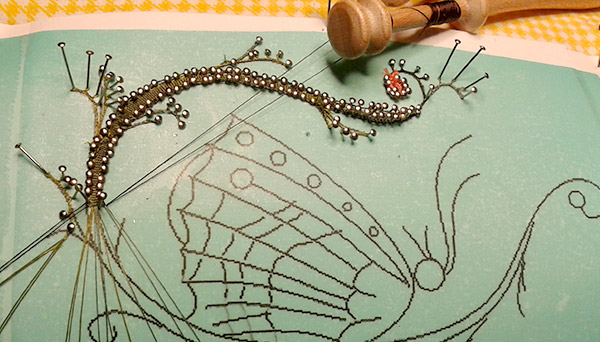
Mother, wife, worker and... embroiderer and lacemaker, arts belonging to the feminine world through the need for kindness, grace and patience: innate attributes of women who, throughout history, spun fabric, sewed, embroidered and laced, not always for pleasure but also with great effort and sacrifice. Over time I realised how stories, tales and local memories represent a rich heritage that reminds us of our distant origin and becomes the protagonist of important sources of inspiration that allow for the creation of modern and contemporary products.
My training as a lacemaker took place at the association “Il fusillo” ("The spindle") in Cesena where, in collaboration with the teacher Antonia Busi, I undertook and conducted the study, research and the creation of "Cesena Lace", inspired by illuminated manuscripts and the choir of the Malatesta Library in Cesena. An interesting study, still in its evolutionary phases, but which has already collected gratification and great satisfaction with an exhibition of the work in antique display cases, alongside the original manuscripts. Butterflies in silk and cotton assume a particular importance and interest: these are moulded to a stranded wire with the technique of bobbin lace. Local legends attributed these as the symbol of the pious Violante, wife of Novello Malatesta, but in reality they depict the spirit of the soul that frees itself from material nature, becoming, in this context, a symbol of the human mind that frees itself from ignorance and flies towards knowledge.
My curiosity towards everything I could potentially create with my own two hands as if inexplicably by magic and towards everything that enabled me to dream led me to explore the world of embroidery. Of pivotal importance was my encounter with teacher, historian and researcher Rosalba Pepi. Her work in the recovery of traditional culture enabled me to learn about the different embroidery techniques, which in turn allowed my instinct to wander in the direction of experimentation and the creation of contemporary artefacts.
DEL BIANCO APARTMENTS
via Michelangelo, 7 - 47838 Riccione
Tel. 0541.602995 • 380 3225933
E-mail: info@appartamentidelbianco.it
CIN: IT099013B4T7UU6LFT
CIR: 099013-CV-00027
By car:
A14 – Motorway way out Riccione and then direction Riccione Terme.
By train:
Riccione-Railway station or Rimini-Railway station with several bus and taxi stops.
By Plane:
The airport of Rimini-Miramare is only 5 km from our house.
